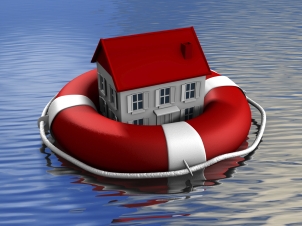
Rising Home Prices Float 1.4 Million Underwater Homeowners Above Negative Equity
By Gretchen Wegrich Updated on 1/17/2013By Gretchen Wegrich
Rising home prices helped 1.4 million homeowners escape negative equity during 2012, revealed a report released by housing data powerhouse CoreLogic. The number of homeowners reaching a state of positive equity rose by approximately 100,000 during the third quarter of 2012, adding on to the more than 1.3 million borrowers who achieved positive equity during the first and second quarters of 2012.
Negative equity, typically called being “underwater” or “upside down,” means a borrower owes more on their mortgage than their home is worth. Negative equity happens when a home value declines, a mortgage debt increases, or a combination of both.
The report released by CoreLogic also showed 10.7 million or 22 percent of all residential properties with a mortgage were in negative equity at the end of the third quarter of 2012. Although significant, this figure had dropped from 10.8 million at the end of the second quarter of 2012.
“There has been steady progress relative to reducing negative equity and its effects in 2012, but with nearly one quarter of borrowers still underwater, we have a long way to go,” said Anand Nallathambi, president and CEO of CoreLogic. “As we look ahead into 2013, we expect to continue to see more borrowers escape the negative equity trap, which will be a strong positive for the housing market specifically, as well as the broader economy.”
At the end of the third quarter of 2012, 1.8 million borrowers were just five percent underwater. For this group, a positive equity position is possible if home prices continue to rise as predicted during 2013.
Hovering just above negative equity in what is referred to as “near-negative equity,” were an additional 2.3 million borrowers who held no more than 5 percent equity in their home at the end of the third quarter.
Negative equity and near-negative equity mortgages combined totaled 26.8 percent of residential properties with a mortgage during the third quarter of 2012, down from 27 percent at the end of the previous quarter. Rising housing prices were a significant contributing factor to the decrease in underwater or at-risk mortgages.
“Through the third quarter, the number of underwater borrowers declined significantly,” said Mark Fleming, chief economist for CoreLogic. “The substantive gain in house prices made in 2012, partly due to tight inventory caused by negative equity’s lock-out effect, has paradoxically alleviated some of the pain.”
The nation-wide negative equity level decreased from $689 billion during the second quarter to $658 billion at the end of the third quarter, a decrease of $31 billion. The dollar amount is representative of the total value of all homes currently underwater in the US.
Notably, the vast majority of negative equity is stored in the low end of the housing market. Low-to-mid-value homes (valued at below $200,000) have a negative equity share of 28.7 percent, nearly double the 14.6 percent share held by borrowers with home values above $200,000.
At the closing of the third quarter of 2012, 17.1 million borrowers held qualifying LTVs ranging between 80 and 125 percent for the Home Affordable Refinance Program (HARP) under the program’s original requirements established in March 2009. With the introduction of HARP 2.0 and the lifting of the 125 percent LTV cap, another 4.6 million borrowers are eligible for a mortgage refinance.
States with the highest percentage of negative equity:
-Nevada (56.9 percent)
-Florida (42.1 percent)
-Arizona (38.6 percent)
-Georgia (35.6 percent)
-Michigan (32 percent)
The CoreLogic report was generated using data from 85 percent of all residential property mortgages in the US.
To learn more about mortgage refinancing and current rates, click here.

Didn't find the answer you wanted? Ask one of your own.
-
 What You Need To Know About Escrow
View More
What You Need To Know About Escrow
View More
-
 President Obama Initiates Lower FHA Mortgage Insurance Premiums
View More
President Obama Initiates Lower FHA Mortgage Insurance Premiums
View More
-
 What is Quantitative Easing?
View More
What is Quantitative Easing?
View More
-
 The 5 New Mortgage and Housing Trends for Summer 2013
View More
The 5 New Mortgage and Housing Trends for Summer 2013
View More
-
 Fannie Mae profitability skyrockets
View More
Fannie Mae profitability skyrockets
View More
-
 Foreclosure protections for more soldiers after lawmakers draft bill
View More
Foreclosure protections for more soldiers after lawmakers draft bill
View More
-
 FHFA: HARP success follows low mortgage rates, February refinance volume strong
View More
FHFA: HARP success follows low mortgage rates, February refinance volume strong
View More
-
 Use of Mortgage Interest Deduction Depends on Where You Live
View More
Use of Mortgage Interest Deduction Depends on Where You Live
View More
-
 HUD will sell 40,000 distressed loans in 2013
View More
HUD will sell 40,000 distressed loans in 2013
View More
-
 Mortgage Principal Reduction Could Save Taxpayers $2.8 Billion
View More
Mortgage Principal Reduction Could Save Taxpayers $2.8 Billion
View More
-
 Mortgage Applications Regain Traction after Sluggishness, Rates Continue to Fall
View More
Mortgage Applications Regain Traction after Sluggishness, Rates Continue to Fall
View More
-
 HARP 3.0 Discussions Reveal Little Hope for HARP Update
View More
HARP 3.0 Discussions Reveal Little Hope for HARP Update
View More
-
 Home Prices Rise in February According to LPS Data
View More
Home Prices Rise in February According to LPS Data
View More
-
 Balancing Act: House Committee Hears Opposing Viewpoints Over Mortgage Interest Rate Deduction
View More
Balancing Act: House Committee Hears Opposing Viewpoints Over Mortgage Interest Rate Deduction
View More
-
 Near Record Low Mortgage Rates Buoy Housing Recovery
View More
Near Record Low Mortgage Rates Buoy Housing Recovery
View More
Related Articles
Ask our community a question.
Searching Today's Rates...

Featured Lenders
Lisa Stepp
RBS Citizens
Clifton Park, NY

